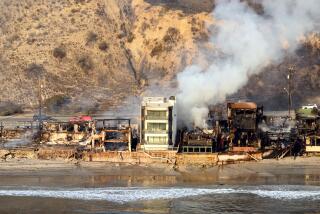Quake Jolts Faith in Steel Frame Buildings : Disaster: About 20 are now known to have been damaged. Engineers call for inspections to search for hidden flaws.
- Share via
With the tally of steel frame buildings found to have suffered cracked girders and welds in the Northridge earthquake continuing to rise, experts Thursday called for random inspections to assess the nature and scope of the problem.
The number of buildings where steel frame elements failed in the Jan. 17 quake is now thought to be about 20 and is growing as more owners order in-depth reinspections. Engineers said the potentially dangerous cracks may not be visible unless parts of walls and fireproofing material around steel columns and beams are removed.
Engineers also told a meeting of the state Seismic Safety Commission in Burbank that, because the internal failures caused by the recent quake were often obscured, steel frame buildings in the San Francisco Bay Area should be checked for damage that might have occurred in the 1989 Loma Prieta earthquake.
Steel frame buildings are supposed to bend with the forces of an earthquake without breaking and, if properly designed and constructed, are still thought to be among the safest of modern structures. But engineers say a number of these buildings, ranging geographically from West Los Angeles to the Santa Clarita Valley, did not perform as expected in the Northridge quake.
“There’s no reason to push the panic button,” said Helmut Krawinkler, a Stanford University expert on steel frame buildings and earthquakes who stressed that none of the damaged buildings came close to collapsing. “We don’t have a disaster, but we have a problem.”
Krawinkler said three types of steel frame buildings that together comprise a majority of the commercial structures and high-rises erected in recent decades, had girders and welded connections that fractured in the quake. The damage to so-called moment-resisting frames was the most widespread and the most surprising, he said.
“We don’t know how many (damaged steel frame buildings) are out there,” said Krawinkler, who was part of an engineering reconnaissance team that studied the effects of the quake. “That is our immediate concern.”
At the least, he said, all steel frame buildings that suffered any damage should be thoroughly checked, even though each inspection would be “very, very time consuming and expensive.”
Paul Fratessa, an Oakland-based structural engineer who serves on the commission, said the cracked frames do not represent an immediate threat to safety, but he endorsed the call for more inspections.
If initial findings indicate a need for a systematic study, Fratessa suggested that banks, insurance companies, the Federal Emergency Management Agency and building owners could help pay for it. “As opposed to taxing the people of California to do something for a few select owners, I think it will be in the interest of the owners themselves . . . to do this,” Fratessa said.
Several engineers have suggested that badly designed beam-to-column connections or poorly executed welds could have caused the cracks. And others have said that the quality of the steel involved may be suspect. For now, however, the focus is on determining the extent of the damage.
Charles C. Thiel Jr., a Bay Area structural engineer who heads the California State University system’s seismic review board, said that as many as five new or nearly new steel frame buildings on the Cal State Northridge campus may have cracked girders or welds. But officials there did not even begin looking for the problem until there had been several aftershocks.
The aftershocks caused disproportionate damage to the Oviatt Library, so engineers began searching for hidden weaknesses in the building. That is when they found that numerous four-inch-thick steel plates at the base of columns had split. Now cracks are showing up in the engineering, student union and education buildings, which are still under construction.
“What is so troubling about this is that it’s much more insidious,” Thiel said. “The normal signs of damage are not there.”
More to Read
Sign up for Essential California
The most important California stories and recommendations in your inbox every morning.
You may occasionally receive promotional content from the Los Angeles Times.













